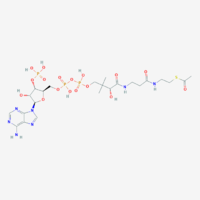Difference between revisions of "Acetyl-CoA"
| Line 1: | Line 1: | ||
{{MitoPedia | {{MitoPedia | ||
|description=[[File:Acetyl coenzyme A 700.png|left|200px|acetyl-CoA]]''' | |description=[[File:Acetyl coenzyme A 700.png|left|200px|acetyl-CoA]]'''Acetyl-CoA''', C<sub>23</sub>H<sub>38</sub>N<sub>7</sub>O<sub>17</sub>P<sub>3</sub>S, is a central piece in metabolism involved in several biological processes, but its main role is to deliver the acetyl group into the [[TCA cycle]] for its oxidation. It can be synthesized in different pathways: (i) in glycolysis from [[pyruvate]], by pyruvate dehydrogenase, which also forms NADH; (ii) from fatty acids β-oxidation, which releases one acetyl-CoA each round; (iii) in the catabolism of some amino acids such as leucine, lysine, phenylalanine, tyrosine and tryptophan. | ||
<br>In the mitochondrial matrix, acetyl-CoA is condensed with [[oxaloacetate]] to form [[citrate]] through the action of [[citrate synthase]] in the [[tricarboxylic acid cycle]]. Acetyl-CoA cannot cross the mitochondrial inner membrane but citrate can be transported out of the mitochondria. In the cytosol, citrate can be converted to acetyl-CoA and be used in the synthesis of fatty acid, cholesterol, ketone bodies, acetylcholine, and other processes. | |||
|info=[[Gnaiger 2014 MitoPathways]] | |info=[[Gnaiger 2014 MitoPathways]] | ||
}} | }} | ||
Communicated by [[Cecatto Cristiane]] last update 2020-10- | Communicated by [[Cecatto Cristiane]] and [[Iglesias-Gonzalez javier]]last update 2020-10-20 | ||
{{MitoPedia concepts}} | {{MitoPedia concepts}} | ||
{{MitoPedia methods}} | {{MitoPedia methods}} | ||
Revision as of 13:38, 20 October 2020
Description
Acetyl-CoA, C23H38N7O17P3S, is a central piece in metabolism involved in several biological processes, but its main role is to deliver the acetyl group into the TCA cycle for its oxidation. It can be synthesized in different pathways: (i) in glycolysis from pyruvate, by pyruvate dehydrogenase, which also forms NADH; (ii) from fatty acids β-oxidation, which releases one acetyl-CoA each round; (iii) in the catabolism of some amino acids such as leucine, lysine, phenylalanine, tyrosine and tryptophan.
In the mitochondrial matrix, acetyl-CoA is condensed with oxaloacetate to form citrate through the action of citrate synthase in the tricarboxylic acid cycle. Acetyl-CoA cannot cross the mitochondrial inner membrane but citrate can be transported out of the mitochondria. In the cytosol, citrate can be converted to acetyl-CoA and be used in the synthesis of fatty acid, cholesterol, ketone bodies, acetylcholine, and other processes.
Reference: Gnaiger 2014 MitoPathways
Communicated by Cecatto Cristiane and Iglesias-Gonzalez javierlast update 2020-10-20
MitoPedia topics:
Substrate and metabolite

